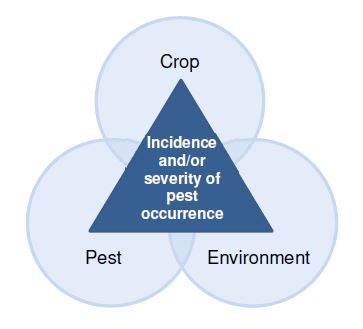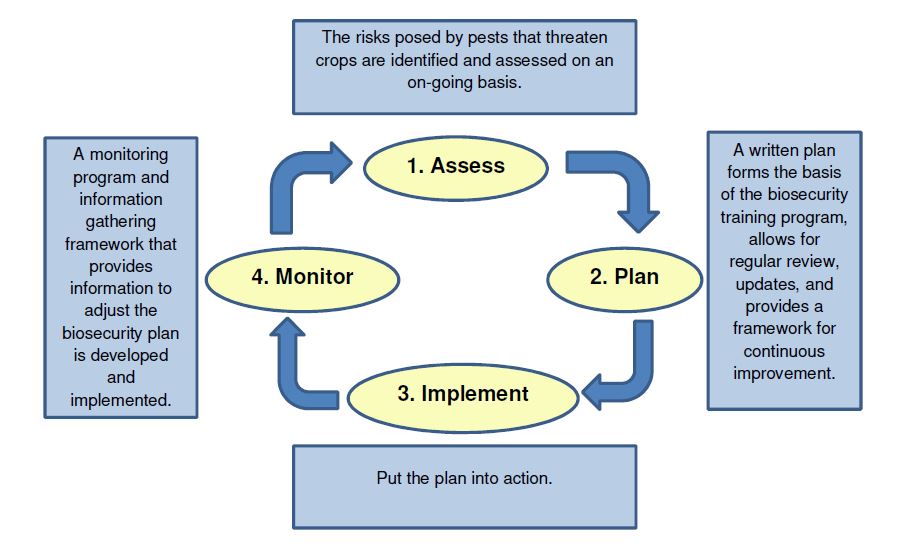Nursery Sector Biosecurity Guide
1.0 Introduction
1.1 The Importance of Biosecurity
Biosecurity is a set of practices used to prevent, minimize and manage the transmission of pests including their introduction, spread and release. Implementing and enhancing biosecurity measures within a nursery will help protect both individual and sector-wide economic interests. Risks to nurseries may develop rapidly and easily spread to other nurseries or the surrounding landscape due to the intensive nature of production, limited genetic diversity within crops and the movement of people and materials. Producers will benefit from awareness of the risks and the measures that can be implemented to minimize the risk of pest introduction and spread.
1.2 Biosecurity Concepts
Biosecurity ConceptsFootnote 1
Target Outcome
Implementation of biosecurity measures at critical points in pathways of pest transmission.
Implementing biosecurity measures can be effective not only for mitigating the spread of pests but also for preventing the introduction of new and unknown pest risks. Applying biosecurity measures depends on an analysis of the risks and pathways of pest transmission for a nursery. The risks to a nursery will vary depending on several factors, such as the type of crop grown, the source(s) of propagative material, the region, the climate and the production practices.
Knowledge of pests and their pathways of transmission is important when developing a biosecurity plan. With this knowledge, pest vectors can be managed and biosecurity measures can be applied to interrupt pathways of pest transmission to reduce crop damage and minimize economic losses. Pathways of pest transmission include:
- Biological vectors such as incoming plants, insects (including beneficial insects) and people.
- Physical vectors such as equipment.
- Environmental vectors such as wind and surface water.
To determine the critical points in the pathways of pest transmission for a nursery where biosecurity measures may be applied, a risk assessment may be conducted. This risk assessment should examine all steps in nursery production from the location and layout of a nursery to shipping finished product. Appendix 1 is taken from the Clean Plants Nursery Manual and is an example of a risk assessment tool.
In addition, as illustrated in Figure 1, pest outbreaks do not happen in isolation but are dependent on the interrelated nature of the crop, the environment and the pest.
- Crop health: If the crop is not healthy and under stress the plant can be more susceptible to pests. However, if the plants are healthy this does not eliminate pest issues.
- Pests: Many pests can thrive in optimal crop growing conditions.
- Environment: The environment is important to the development of the crop and the pest.
Figure 1: The Plant Pest Triangle

Description for photo - Figure 1: The Plant Pest Triangle
The Plant Pest Triangle has a triangle with the words "Incidence and/or severity of pest occurrence" written on it. Each point of the triangle has a circle surrounding it. Starting at the top, the first circle says: Crop. To the right, the second circle says: Environment. To the left, the third circle says: Pest.
The Plant Pest Triangle shows that the incidence and severity of an outbreak relates to the interaction of a susceptible crop, a pest, and an environment favourable to pest development. In addition to applying biosecurity measures at critical points in the pathway of transmission, pests may also be mitigated through the application of biosecurity measures to reduce the risks presented by these three components. For example, a producer may choose to grow tolerant plant varieties or manage the environment.
1.3 Benefits of a Biosecurity Plan
One benefit of a biosecurity plan is that it can provide producers with the less costly option of preventing rather than managing the introduction or spread of pests. If a pest is detected, there are protocols already in place to facilitate a rapid response, thereby minimizing the damage or further spread of pests. Other benefits of incorporating biosecurity measures into the day-to-day activities of a nursery include:
- Managing the risk of business interruption due to harmful pest detections.
- Meeting customer and consumer demand for biosecurity measures and protocols.
- May assist in attracting new markets.
- Decreased production losses.
- Avoiding the introduction of pests that are currently not present.
- The ability to contain and minimize pests that are already present.
- Breaking the cycle of pest transmission from one nursery to another, to the wider community and between trading partners.
It is preferable to prevent rather than manage the introduction or spread of a pest within a nursery.
1.4 Elements of a Biosecurity Plan
Biosecurity plans will differ from one nursery to another, as biosecurity measures and requirements will vary depending on the nursery. A biosecurity plan may include a detailed farm map(s), training programs, and standard procedures for pest response and the movement of people, vehicles and equipment. Documenting these procedures can ensure consistent application and demonstrate to customers that a nursery operates under biosecurity measures.
Other programs such as the Clean Plants Nursery Manual may already be used within a nursery and have components that apply to biosecurity. These programs can be referenced as part of a biosecurity plan.
To develop a biosecurity plan, consider the following process:
Step 1: Develop a detailed map of the nursery. A map can be useful for visualizing and identifying potential sources or pathways of pest transmission. A map may include the entrance, shipping area, receiving area and biosecurity zones. The flow of plant material, people and equipment within the nursery can also be included.
Step 2: Identify the risks to a nursery. Knowledge of pests and their pathways of transmission can help to identify the risks and biosecurity measures that can help mitigate pests. Appendix 1 is an example of a risk assessment tool.
Step 3: Review current biosecurity measures. The self-assessment checklists and the Nursery Sector Biosecurity Guide Self-Assessment Checklist and Action Work Plan can be used to help identify additional biosecurity measures that may be implemented at a nursery.
Step 4: Identify biosecurity goals. Prioritize and establish a timeline for the implementation of the additional biosecurity measures identified after completing the self-assessment checklists or the Nursery Sector Biosecurity Guide Self-Assessment Checklist and Action Work Plan.
Step 5: Develop an implementation strategy. Communication, education and training of employees and visitors of a nursery are an important part of the implementation strategy.
Step 6: Review and update the biosecurity plan. A biosecurity plan should be regularly reviewed and updated as new biosecurity information becomes available or if there are changes within a nursery.
1.5 Implementing a Biosecurity Plan
As seen in Figure 2, the implementation of biosecurity measures in a nursery is a cycle of biosecurity activities. The cycle of assessing and re-assessing leads to a more proactive approach.
Figure 2: Cycle of biosecurity activities

Description for photo - Figure 2: Cycle of biosecurity activities
Figure 2 is an illustration of the cycle of activities that should be completed to develop and implement a biosecurity plan. The cycle of biosecurity activities has four items in the centre with arrows pointing between them in clockwise direction. The first item at the top of the cycle is Assess. Moving clockwise, the second item is Plan, the third item is Implement and the fourth item is Monitor. There is a text box by each of these items in the cycle (four in total). Above the word Assess there is a box with the following text: The risks posed by pests are identified and assessed on an on-going basis. To the right of the word Plan there is a box with the following text inside: A written plan forms the basis of the biosecurity training program, allows for regular review, updates and provides a framework for continuous improvement. Below the word Implement is a text box with the following text inside: Put the plan into action. To the left of the word Monitor is a text box with the following text: A monitoring program and information gathering framework that provides information to adjust the biosecurity plan is developed and implemented.
Assess: Identify and assess the risks of pest introduction and analyze their pathways of transmission. This will allow for current biosecurity gaps within a nursery to be addressed. Production practices should be reviewed frequently (re-assess) to ensure that implemented measures are effective in relation to pest prevention and control.
Plan: A written biosecurity plan is highly recommended. A written plan allows for regular review and updates, facilitates continuous improvement within the nursery, and forms the basis for training.
Implement: Put the plan into action. Education, training and communication are key to implementing a biosecurity plan.
Monitor: A monitoring program is developed and implemented for the early detection, identification and ongoing monitoring of pests. It is important that the design, effectiveness and implementation of a biosecurity plan be assessed not only on a routine basis but also when changes in nursery practices or biosecurity risks occur.
- Date modified: